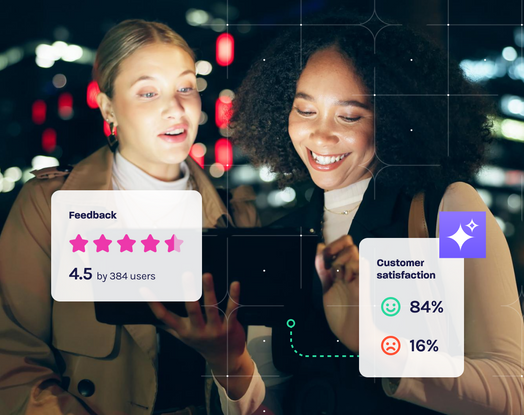
Enhancing your website or mobile platform with customer insight tools and solutions
When constructing the ideal website or mobile app, you want your development to be malleable enough that it can adjust to needed changes over time. The key is finding out what those changes are. If your site is too rigid or offers only a limited number of paths to the target page, users might be turned away and choose to visit another site instead. In addition, the more errors a user encounters, the less likely they are to follow through with a transaction.
A user’s experience is based on three dimensions: their overall experience on the platform, the ease of completing the intended process, and the general accessibility and appearance of the site. The right tools can help adjust your digital customer journey and increase the likelihood that a user will return to your site. You can gain insight into this journey through many different customer insight solutions, including functionalities such as session replay, real-time struggle analysis and alerts, automated anomaly detection, etc. By implementing these tools in the most efficient manner, you will be able to determine what upgrades need to be made to your site in order to make it as user-friendly and revenue-driven as possible.
Understanding the customer experience
Prior to this age of comprehensive digital analytics, the customer experience could only be explored at a very basic level and it was incredibly difficult figuring out how to gain customer insight. Basic website analytics could tell you how many times a link was clicked, or how many times an error occurred. What it couldn’t tell you is why all of these things happened. Now, digital customer analytics and other customer insight tools have taken customer insight to a new standard. Customer insight solutions allow you to see the whole transaction or path the user took on any device at any time.
Marketing Week’s research says that, “15 years ago, the average consumer typically used two touch-points when buying an item and only 7% regularly used more than four. Today consumers use an average of almost six touch points, with 50% regularly using more than four.” This means that a user is taking almost twice as long to get from the beginning of their process or transaction to the final step. This leaves a lot more room for something to go wrong, and if you don’t have a 360-degree view of the entire interaction, you may miss a point for critical development or the cause of a crucial error.
The user’s path is also the place where many relationships are built. The reliability of a system can make or break a consumer’s relationship with the company. According to McKinsey and Company, “Over half of all customer interactions happen during a multi-event, multi-channel journey.” With that said, a disjointed customer experience could ultimately be costly for your company in the long run. Hence the paramount importance of customer insight tools.
Utilizing the information silo
Once you start tracking the digital customer analytics, what do you do with all the information you collect?
One of the most critical tools is the flexible data export that allows the information collected to be disseminated to all departments and enrich other systems. Rather than only granting your analysts access to the statistics, marketing, design, and call center teams can now evenly contribute as to what they think is going right or wrong with the website. By employing these tools, you’re not just creating a more streamlined experience on the front end; you’re creating one on the back end, as well. Website creation is not done by one person, and by sharing the information gathered through these measures, collaboration can take place among your team to build the best website possible. Put simply, many different team members need to know how to gain customer insight for the website or mobile app.
Here is how you can implement those customer insight tools and extract the best knowledge out of them for the most effective digital customer experience management:
- Session replay– Rather than trying to recreate an error that a customer experienced, see how it happened instead with a 360-degree view of every interaction that occurred on your site during that transaction. What path did the customer take that they ultimately ended up with an error? Was it a one-time instance, or does it need a more permanent fix? From a customer session replay, you can identify the length of time spent on each site, the effectiveness of target ads, and how to make customer journey more straightforward overall.
- Real-time troubleshooting– When customers call your contact center to resolve or report an issue, you don’t want your support staff spending a long time trying to find them a solution. As such, they need to know how to gain customer insight and how to do so quickly and efficiently. Access to the session replays can help your customer care representatives identify an issue faster, and figure out how it can be handled, if it cannot be solved by the support team themselves. By improving the efficiency of the customer service team, you will see a more satisfied and more loyal customer base- the main goal of taking steps to improve the digital customer experience.
- Lifetime record-keeping– Many companies have different requirements for the length of time for recorded data to be saved. These tools make sure you can keep your data saved for as many months or years as necessary. This can come in handy to track trends over time, to see what adjustments worked and what didn’t, and to track overall experience performance. That way, even if changes were initiated but were unsuccessful, the company has record of that action and will avoid trying to duplicate the same action.
- Up-to-date data security– Keeping your recorded data secured should be the primary concern for you and your clients. Whether it is to comply with federal regulations or take extra precautions on behalf of your customers, data security should take precedent, whether it is cloud or portal-based. By keeping your security aligned with current regulations, you can be prepared for any audits, oversight reviews, or client inquiries into the safety of their data.
We are in a new digital age where no company can afford to be basic anymore. This is the time for the customer experience to be taken to the next level, and to be understood at the highest level. There are numerous benefits to customer insight solutions, and many ways the tools provided can be used to extract the information your company needs to build a successful platform. When used cohesively, the amount of data available to you and your team can be extraordinary.
What customer insight solutions mean for the long term
By keeping records of changes in customer behavior over time, you can make your website or mobile app more adaptable to customer behaviors. Whether it’s adjusting button placement, identifying and correcting repetitive common errors, or realigning the placement of critical text, customer insight tools can help you see the website through the eyes of the customer. Implementing these tools can mean improved satisfaction, a smoother customer experience, and a more optimal outcome at the end of the transaction.
According to Salesforce, “75% of consumers expect a consistent experience wherever they engage (e.g., website, social media, mobile, in person)” and “86% of senior-level marketers say that it’s absolutely critical or very important to create a cohesive customer journey.” What’s needed are the tools to make these paths not just cross, but align with one another so that marketers are able to create that ideal journey and customers are able to benefit from it. It is possible to create a journey that customers still cannot fully benefit from, because if managers focus too much on the business side and not the customer’s perspective, the result will not be the desired one. Customer insight always needs to be put first in web and mobile management in order to reach the desired outcome.
Creating the best website and mobile app possible
In this smartphone-reliant era, every website that is created needs two forms: one for standard desktops and one for mobile devices. Images and text sizes can skew the appearance of a page and make it unfriendly for the user.
However, it’s not just appearance that can deter a potential customer. The site needs to be intuitive. Andy Yannett, the CMO of Gannett, said, “2018 will be the year of servicing consumer needs before they even arise. Brands leveraging the right data and analytics to deliver impactful customer experiences will rise to the top.”
The information that you garner from customer insight solutions can be turned into valuable data when it comes to redesigning or reprogramming your web or mobile site. From areas of the site neglected to pages that have graphics that repel users, the more you know about navigation paths and customer preferences, the better. A user-friendly website builds brand loyalty. In fact, the Temkin Group reports that “Loyal customers are 5x as likely to repurchase, 5x as likely to forgive, 4x as likely to refer, and 7x as likely to try a new offering”.
Understanding the customer experience needs to be an intuitive process rather than a reactive one. However, until the day that machines can correctly predict every possible digital path a customer can take, customer reactions are the key to building a better platform. So make sure you know how to gain customer insight at all times. A big data solution for digital customer analytics like Glassbox can help you bridge the divide between the data from your mobile platform and your website and pilot a less ambiguous and more effective direction. By watching and listening to the user, your company elevates digital customer service to a new level.







